Last Updated: 1 month ago
Are you wondering how to keep litter from sticking to the litter box?
It’s normal to wonder if such a feat is possible when you spend hours scraping the hard clumps from the bottom of the box.
Fortunately, I’m here with a few litter box hacks to make your job a piece of cake.
Just keep reading.
7 ways to Keep Litter From Sticking to the Litter Box
Maintaining a clean toilet box is essential for you and your cat’s health. A dirty toilet is a breeding ground for bacteria and parasites, which your cat can spread all over the house with its paws.
Moreover, cats hate the smell of a dirty toilet and will refuse to do their business in the tray. And once a cat develops a surface preference, it will be hard to retrain it to use its toilet box.
So, how to keep litter from sticking to the litter box? The easiest way is to apply an anti-stick coating, switch to non-clumping litter, or use an automatic litter box.

But let’s talk in detail about what you can do to keep the box mess-free.
1. Apply Anti-Stick Spray and Baking Soda
You probably have non-stick cooking spray and baking soda lying somewhere in your kitchen cabinets. Do you know that they can be useful to keep cat urine from sticking to the litter box? Here’s how:

- Clean the toilet box as thoroughly as possible with warm water and dry it.
- Spray the bottom and walls with non-stick spray.
- Sprinkle some baking soda.
- Fill the box with a couple of inches of cat litter.
I like this method because it’s easy to use and you don’t have to wonder where to find the ingredients. However, the non-sticking coating lasts only for a couple of days, after which you have to reapply.
Also, some cats don’t like the scent of the anti-stick cooking sprays, and some household anti-stick sprays can be dangerous for use around cats.
If you aren’t confident your cooking spray is safe for cats, you should purchase a specific non-stick litter spray.
Pros
- Cheap
- Easy to use
- Effective
- Quick to apply
Cons
- It lasts a couple of days
- Not all cats like the smell
2. Apply Wax Paste
Wax paste is another great alternative to non-stick sprays because it’s water-repellent and will prevent litter clumps from sticking to the bottom and walls:
- Clean the box and let it dry.
- Get a cleaning cloth and apply the wax paste on the bottom and walls in an even, thin layer.
- Let it dry and apply a second layer of wax.
- Once the second wax layer dries fully, you can add the litter.
- Reapply every couple of months.
However, not all wax is safe for cats, so you need to find a non-toxic, food-grade paraffin wax paste.
Pros
- Wax paste lasts a couple of months
- Cheap
- Easy to use
Cons
- Application takes time
3. Get Litter Box Liners
If you’re not a big fan of scooping and scraping your cat’s toilet box, litter liners will be a great tool in your fight against sticky clumps:
- Choose a suitable liner based on the toilet box’s size.
- Drawstring liners are great since you can close the bag and toss it in the trash without spilling any of the mess. Sift liners are also excellent because you don’t have to throw the whole mess.
- Clean the box until it’s sparkly clean.
- Apply the liner on the bottom and over the walls.
- Pull the drawstrings closed when it’s time to scoop the box and throw the liner away.
I also like liners because some brands have odor control properties and reduce the bad smell of cat waste. And there’s no mess on the floor when changing the litter.
Check this video for a demonstration.
Unfortunately, the best cat litter box liners are expensive, and it’s not easy to carry the heavy bag to the trash can. Moreover, some cats dig so much they can tear the liner and create a big mess.
However, if you wish to reduce the costs, you can use garbage bags. But while cheaper, they’re very flimsy.
Pros
- Mess-free
- Easy and quick to use
- Available in every pet store
Cons
- Expensive, especially if you have more than one cat
- Some cats can tear down the material
4. Switch to a Non-Stick Litter Box
Most toilet boxes are made of plastic, which is easy to scratch. As such, it’s no wonder that clumps stick to the bottom and walls and that the box has such a bad smell.
So, you can solve the problem by getting a non-stick cat litter box, such as a stainless steel box with a non-stick coating.
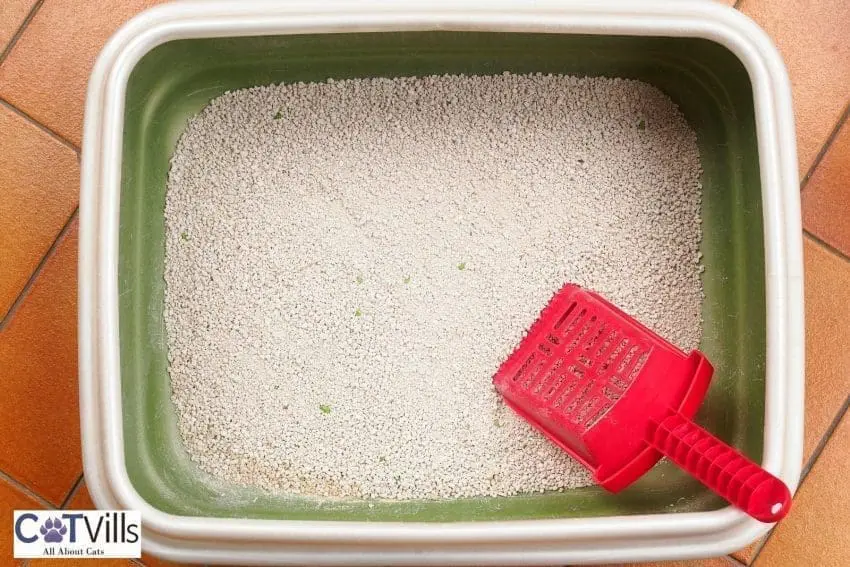
Moreover, stainless steel is scratch-resistant, so your cat won’t be able to damage the protective coating with its claws. And it won’t trap foul odors the same way plastic does.
As such, it’s a very affordable solution to cat urine sticking to the bottom of the box.
Just remember to pick the right size. A rectangular-shaped box that is 1.5× the length of the cat (from nose to base of tail) or a minimum of 22 × 17 inches.
Pros
- Cheaper in the long run
- Easy to maintain
- Less odor and bacteria
Cons
- It takes time for cats to get used to a new toilet box
- Not all like stainless steel surfaces
5. Use Self-Cleaning Cat Toilet Boxes
If you don’t want to bother scooping and cleaning the toilet box every day, an automatic litter box will be the perfect solution for you.
These boxes have sensors that detect when your cat has used the box and scoop the urine clumps into a bottom waste drawer. All you have to do is clean this drawer on a regular basis.
Unfortunately, not all cats like such toilet boxes because they’re noisy. Some felines are also suspicious of covered toilet boxes and are reluctant to enter them.
Moreover, the best automatic litter boxes are expensive and work with a specific substrate – clumping, crystals, granules.
So, you can still train your cat to use automatic toilet boxes, but it will take time and effort.
Pros
- Mess-free
- Easy to use
- Convenient
- Easy to maintain
Cons
- Expensive
- Some cats won’t use an automatic toilet box
6. Change Litter Type
One of the main reasons why you’re having problems with cat poop and urine sticking to the toilet box is the type of litter.
Cheap brands don’t absorb moisture well and don’t have sufficient clumping power. As a result, the waste sticks to the bottom of the box, and you have to scrape the soiled litter.
So, look for a high-quality clay brand or try non-clumping litter. Non-clumping brands don’t form such hard clumps, so there’s less chance of cat waste sticking to the box.
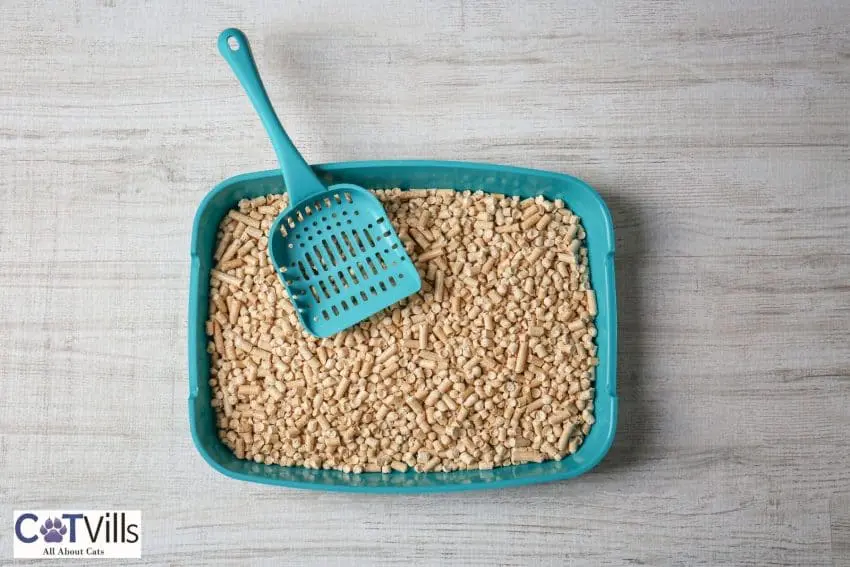
However, non-clumping substrates are often messier to clean than standard brands, even if you don’t have to scrape the mess from the bottom and walls.
7. Use a Putty Knife
Are you having trouble scraping the toilet box with the scoop? Then you can use a putty knife to dislodge the clumps and then clean them.
You just have to be careful not to break down the clumps, and it shouldn’t be too hard to scoop the mess.
How to Keep Cat Urine From Sticking to the Litter Box?
Usually, non-stick toilet boxes, automatic boxes, and cat liners are enough to prevent urine from sticking to the sides and bottoms.
But if you’re still having problems cleaning cat urine from the toilet box, I’ve got a couple of solutions for easy toilet box maintenance.
1. Keep the Litter Deep
Usually, most cat owners use 3-4 inches of substrate. However, if cat urine sticks to the box, you should try increasing the substrate depth to 5-6 inches.
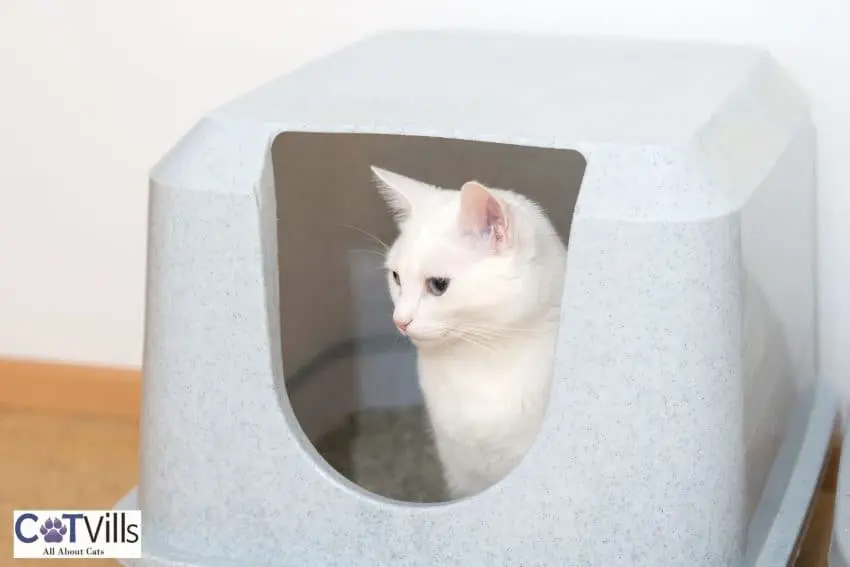
In this way, the extra inches will absorb the urine before it gets the chance to reach the bottom and make a sticky mess.
Unfortunately, the downside is that you will have to use more crystal, granules, or sand than usual, which increases the cost per month.
2. Frequent Cleaning
To prevent litter from sticking to the box, you should clean the toilet as often as possible. In this way, you will remove the clumps before they have the chance to get stuck.
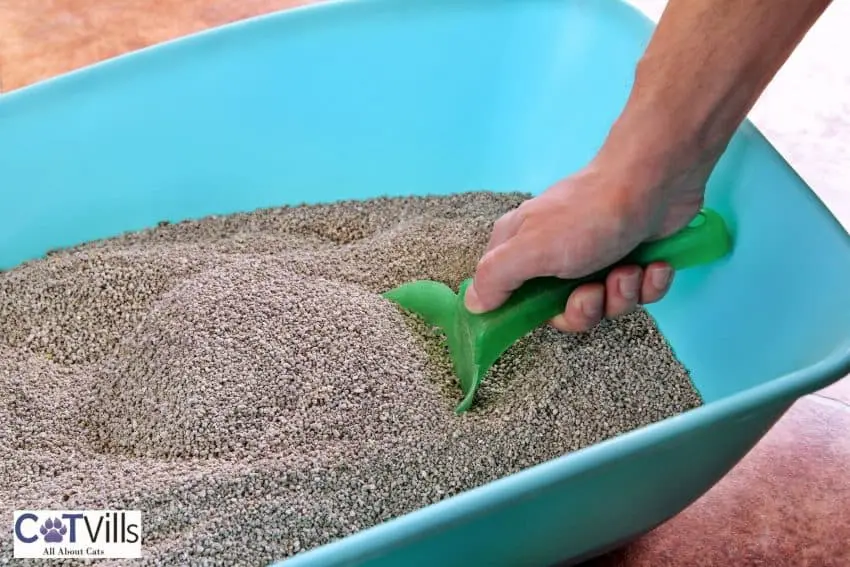
In general, you should scoop the toilet daily and change the substrate every 2-3 weeks. But you can do it as frequently as possible if you’re having problems with sticky litter.
3. Add More Toilet Boxes
If you don’t have enough toilet boxes around the house, it’s no wonder that the mess is sticking to the bottom.
One box for multiple cats means the box will get full of clumps before you know it. And if you don’t scoop right away, the mess will get stuck due to overuse.
Specialists recommend, one box per cat, plus one extra. Moreover, cats often like to use one box for liquid waste and one for solid waste, which can make cleaning the toilet a bit easier.
How Do You Keep Cat Litter From Sticking to Paws?
Dirty cat paws are every cat owner’s nightmare, especially when the cat jumps on counters and walks on tables.
So, how can you keep the litter from sticking to the paws and tracking all over the house? Here are five simple solutions.
1. Use a Litter Mat
To keep tracking around the house to a minimum, you should place a plastic mat around the toilet box.
Such litter mats trap small particles and debris when your cat exits the toilet box, reducing the dusty pawprints around the house.
2. Change the Litter
Non-clumping brands can make all the difference, especially for long-haired cats. Such substrate types tend to cling less to the cat’s paws and are less dusty.
If a non-clumping brand is not an option, pick a fast-clumping brand. It will dry quickly, so the particles won’t stick to the cat’s paws.
Large granules are also better than fine-particle brands since they can’t attach to the cat’s fur and paws so easily.
3. Pick a Larger Box
When you’re wondering about cat toilet box size, it’s always better to go larger than smaller. Otherwise, the cat won’t have enough space to turn and will step into its waste.
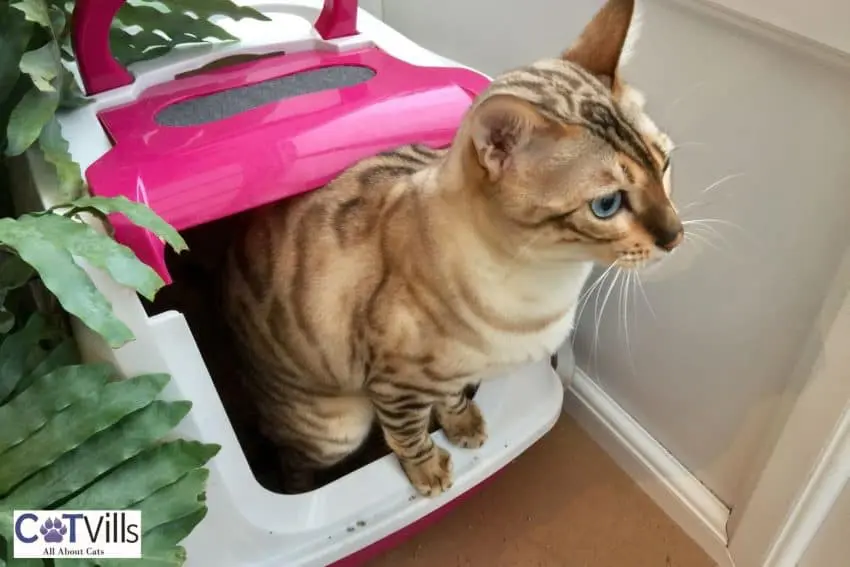
4. Trim Your Cat’s Paw Hairs
If nothing else works, you can trim some of your cat’s fur around the paws to prevent the dirty particles from sticking to the hair.
Use cat grooming scissors and gently shorten the hair around the paws and ankles. Then clean the cat’s paws with a damp cloth when you see your kitty exit the toilet box.
If you’re worried about hurting your feline companion, you should take them to a professional groomer.
FAQs
Should You Line a Litter Box?
You can use liners in your cat’s toilet box. They can make cleaning the clumped mess a bit easy, but some cats don’t like the texture of the liners when they bury their waste.
How Do You Clean Stuck Litter?
Lose the dried clumps with a putty knife. Then wash the toilet box with warm water and scrub it with a clean cloth. Apply a layer of anti-stick spray to prevent clumps from making a future mess.
How Do You Make Scooping Cat Litter Easier?
Scoop the toilet box as soon as your cat uses it and change the litter every two-three weeks. Switch to a non-clumping substrate or apply non-sticking sprays to keep the bottom and sides clean.
Conclusion
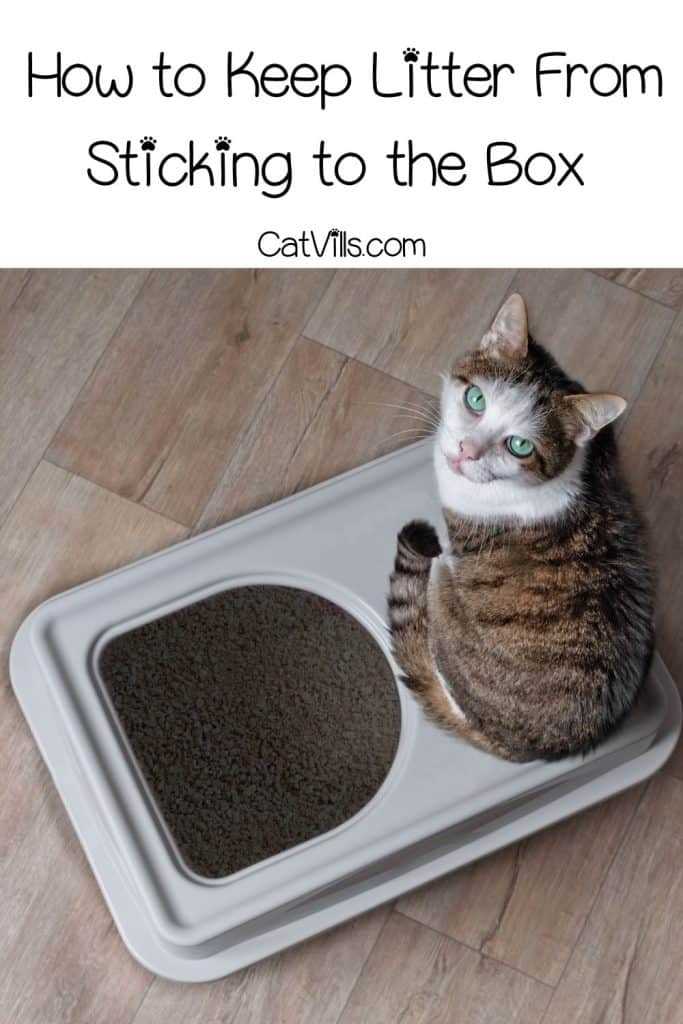

Olfa knows how to get things done and has a keen business sense that others admire. She’s always on the go, coming up with new ideas! Her ability to anticipate the needs of her readers and deliver information that they want is what makes CatVills such a success. She loves cuddling her cat Picaciu. He is her inspiration.
